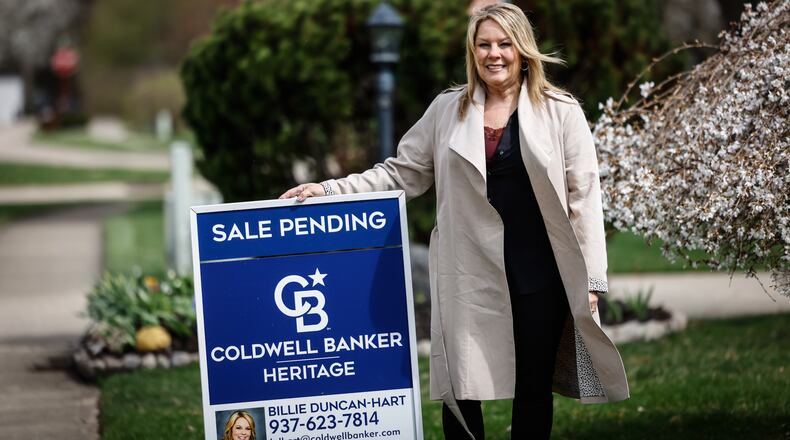It stood at 3.38% one year ago,
Mortgage rates, which are commoditized and similar wherever you go, have risen substantially, according to Joshua Todd, director of real estate lending with Day Air Credit Union, which covers Montgomery County and all the counties surrounding it.
Rates, which were hovering in the low to mid-3% range in December, increased by 1% in February and another 1% since then, Todd said.
“A 30-year-fixed mortgage was running approximately 5.25% a week or two ago,” he said Friday. “As of today, it’s around 5.08%.”
That, he said, will mean a higher monthly payment for borrowers. “It actually makes it more difficult for low to moderate-income borrowers, who are our core constituency, to afford to buy a home, Todd said.
It also affects renters, because if an investor owns a property and a renter is paying rent, that investor is probably paying a mortgage, he said.
A higher mortgage rate also makes it more difficult for lenders to get loans, Todd said.
“Folks don’t want to want to pay the higher rate, so the demand drops pretty substantially,” he said. “So what you have is a bunch of mortgage lenders competing for a smaller pie of business, if you will.”
The general outlook for the immediate future is that rates will continue to trend higher with the Fed’s aggressive policy actions to combat inflation, according to Don Hook, area sales mortgage manager for Fifth Third Bank.
“The demand for purchases remain strong, however, this is tempered significantly by the low inventory level of homes available for sale,” Hook said.
For homebuyers, higher rates are just adding to the financial pain as they weather the storms of the priciest housing market in recorded history.
Billie Duncan-Hart, president of Dayton Realtors and an associate partner with Coldwell Banker Heritage, said higher mortgage rates could push those looking to buy a home to get something under contract even more so than before.
Such a reaction is “typical” when rates rise, but it’s likely too soon to tell how expected increases this year will affect the overall real estate market.
“I don’t foresee it making a huge difference at the moment,” she said.
For lenders and mortgage originators, the labor shortage driving strong employment gains combined with rising prices, is adding upward pressure on costs leading to higher rates, George Ratiu, manager of Economic Research at Realtor.com,
“The bottom line is that mortgage rates are on course to surpass 5%, a level not seen since February 2011, when the typical home in the U.S. was priced at just $166,000 – less than half the price of today’s typical home,” Ratiu said.
For real estate markets, the sharp jump in mortgage rates over the past quarter indicates “a decisive turning point,” he said.
“We entered 2022 on strong footing, with rising job numbers and wage growth driving demand for homes,” Ratiu said. “The shortage of inventory pushed prices to record highs even before the spring season got underway.
At current rates, buyers of a median-priced home are looking at monthly mortgage payments which are $460 higher than a year ago, a 38% increase from April 2021.
“The increase in the cost of financing a home is outgunning the 8% yearly rate of inflation, the 15% rise in home prices, and the 17% advance in rents,” he said. “For many American families, today’s mortgage rates are closing the door on being able to afford to buy a home this spring. We are approaching the tipping point at which market demand is expected to pull back.”
The silver lining to the current affordability crisis is highlighted in Realtor.com’s new seller report, which shows that many homeowners are planning to list their properties for sale in the next few months, Ratiu said.
“The supply boost would be welcome news for this year’s housing market,” he said.
The economy’s “very strong recovery” in the latter stages of the pandemic includes growth in GDP and employment, helping to create a much more favorable landscape for housing, Ratiu said.
“When you pile on top of that the fact that last year we saw mortgage rates at record lows, not surprisingly we have a very active year,” he said. “Interestingly, this year we still expected as we started the year, very strong demand.”
The younger demographic of Millenials and Generation Z is driving much of the housing market, but surging mortgage rates presented a challenge for the first quarter of this year.
Those increased rates means those paying interest on a median priced home of about $405,000, a record high according to Realtor.com data, spend about $360 to $400 a month more.
Incomes recently increased by 5% but inflation rose by 8% and home prices by 15%, the 12th consecutive month of annual increases, leading many first time buyers to drop out of the mortgage qualification box.
Increasing rates are likely to mean home buyers postponing or taking a break from housing in the next few months, Ratiu said. What happens after then is “a little uncertain,” he said.
While the Fed is looking to squeeze the demand side of housing and the economy by making it more expensive for people to borrow, it’s trying to do so without choking consumption and putting the economy into a recession, Ratiu said.
“For housing, while we’ll see a drop in transactions ... what remains is the fact that prices at some point will have to adjust for all these higher mortgages, highest costs,” he said.
A recent survey by Realtor.com showed that more than 60% of homeowners planning to sell this year indicated that they aim to list in the next six months.
“That’s significant, because we are likely looking at the next few months at a hopeful combination of more inventory, more homes for sale, plus a moderation in price growth from these higher mortgage rates, which could actually bring back opportunities for buyers,” Ratiu said.
About the Author

